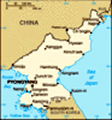Advertisement
Published: August 9th 2007

 North Korean guards, DMZ
North Korean guards, DMZ
Photo by Roland Grondin. North Korean guards sometimes surround the building on the DMZ where the 1953 ceasefire was signed.The demilitarized zone forms the heavily guarded border between North and South Korea, and it is the most dangerous and volatile border in the world. In fact the DMZ is often referred to as the most dangerous place on earth. An uneasy truce prevails between the soldiers of the North and the South, who are assisted by 60,000 US troops. Although the Korean war ended in 1953 a peace treaty has never been signed and the official status of the two armies is still classified as a ceasefire. As you can imagine, this is a very serious hot spot in the world, and it was with some trepidation that I signed up for a tour of the DMZ from Seoul that was run in conjunction with the US military.
We climbed into the bus, dear reader, with our guide for the sixty kilometre drive to the border for an extraordinary day at the DMZ. What a sobering realisation it is to witness just how close Seoul is to the DMZ, with a million North Korean troops posted just across the border in a state of high alert. The north also has a huge barrage of weapons trained on Seoul, and
South Koreans in the capital live with the daily reality they will be the initial target of any attack from the north. South Koreans have compulsory military service and the city is also on a high state of alert. When we arrived at the DMZ we were confronted with what in reality is a war zone. There are massive anti-tank entrapments, and generally it's a bleak and sinister place.
Our guide introduced us to several marines who were to accompany us throughout the tour. We were taken to the DMZ museum, and the guide talked us through several very dangerous incidents that have occurred at the DMZ since the ceasefire with accompanying photographs. These incidents could easily have escalated into a broader conflict. The Korean war lasted for three years and was a terrible war of attrition, where China and the US became increasingly committed to assisting the military causes of the North and the South respectively. The first year following the invasion saw the North push well into the South of the country, but by the time of the 1953 ceasefire they had been gradually forced back to the 38th parallel from where hostilities commenced. Despite great losses
sustained on both sides of the conflict, the combatants were back in the same position they started from.
One notorious border incident saw a dispute over a tree being chopped down end up in the US soldiers being attacked with axes which resulted in a few fatalities, and escalated to the point where US aircraft carriers were placed on high alert nearby. The state of affairs between the protagonists is hair raisingly tense on the DMZ, and we were given specific instructions regarding our brief visit to the DMZ building which straddles the border where the 1953 ceasefire was signed. The North Korean guards stare across the border with malicious intent, and sometimes come down and surround the building when the tours go inside the room. The one upmanship of the North Koreans knows no bounds, even going to the extent of ensuring the flags on their side are bigger than the ones in the South. Our guide told us our only opportunity to visit North Korea was to step on the North Korean side of the room, which we did with some degree of trepidation.
The marines were matter of fact, but surprisingly open in their conversations
with the group. They told us the North Korean guards can be very confrontational, and sometimes eyeball the marines at very close quarters while shouting obscenities. The state of affairs at the DMZ are just so tense, and the marines said that both sides have the biggest and toughest troops facing off against each other. For a civilian it really is quite a frightening and intimidating experience. We were informed the US and South Koreans got wind of digging activity under the DMZ at one stage, and later discovered huge tunnels from the North that could transport tanks and artillery under the border in the event of an invasion. This threat was quickly acted upon and neutralized.
We were also informed the buildings across the border behind the DMZ are just shells. They are purely edifices designed to give the impression of a large North Korean town just north of the border. The North Koreans also blare out propaganda from huge speakers at all hours, and the marines told us they retaliate with rock and roll from their speakers! I was grateful to arrive safely back in Seoul, and the tragedy of the DMZ is that so many Korean families from the area have been arbitrarily split asunder, and unable to make contact with their loved ones for the best part of a generation. I fervently hope for a reunited Korean peninsula in the near future in a country where, basically all of you should be here now!
I will not grieve that men do not know me; I will grieve that I do not know men." Oriental proverb
As I continue my travels, until next time it's signing off for now
Tom
Note: Feel free to post comments on this site, or click on the subscribe button for notification of upcoming travel journals
Advertisement
Tot: 0.324s; Tpl: 0.019s; cc: 42; qc: 155; dbt: 0.1834s; 1; m:domysql w:travelblog (10.17.0.13); sld: 1;
; mem: 1.5mb








Nora
non-member comment
wow
It sounds a little scary.. I am going to Korea in October for just over 2 weeks, and was thinking of going on this tour. How much is it? where do I find out about it etc.